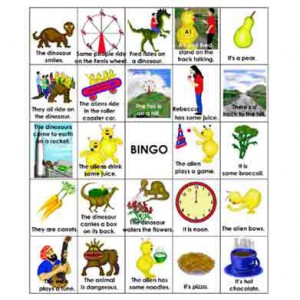
Developing Listening Comprehension in Children
- Posted by Daisy Stocker
- Date May 28, 2018
- Comments 0 comment
Children need to be Active to Learn
If English Second language children are interested and actively involved in what they are doing, they will learn to understand English. This article will present a type of activity that develops listening comprehension.
When children learn their first language they are often responding to their parent’s language in an active way. Their response frequently includes both physical action and verbal understanding. When we consider how much language children learn during those first years of their life, it alerts us to think about how we can duplicate the home situation in the classroom. We need to create a situation wherein they listen and make a physical response.
Criteria for Successfully Mimicking the Language Learning Environment in the Home
– control the difficulty of the language being presented.
An Exciting Story
– present the language in a meaningful and exciting way.
– provide a well organized classroom setting.
– present English in a setting that allows every ESL student to hear.
– motivate the children to listen through the use of pictures.
Action Game
– provide the children with an opportunity to respond physically.
As we consider how we can achieve listening plus a physical response, it’s important to remember that we are teaching listening and understanding. There are many aspects of this that we need to control if we are going to successfully create a learning situation that adapts to the classroom but mimics the first language learning situation of the home. Young children listen and understand before they speak. This activity does not deal with speaking.
Picture Bingo
This game has many advantages:
- it relates the phrases and pictures to a subject they already know about.
- it allows for as much repetition as needed, as the children never get tired of playing.
- a student wins due to chance, and his or her understanding of the phrases.
- it provides enrichment vocabulary using the initial set of pictures.
- the colorful cards can be laminated and used many times.

Suggestions for Playing Picture Bingo
Give each student one Bingo card. If you have more students than cards, several children can have the same card but they shouldn’t be sitting together. The vocabulary will have been introduced in the lesson with the exception of a few words. The children are not expected to know the captions on the first or second time through the game. It is a learning process, so that after a few games they will be able to respond quickly. During the first games help the students and encourage them to help each other. Limit the amount of help as they become familiar with the material.
This simple game effectively integrates visual and auditory input. It is a wonderful motivator as the children never get tired of playing. It is suitable for children with a little vocabulary or for those who have had more experience with English. Children between the ages of six and twelve will find it exciting.
Teaching Listening Comprehension to Kids
- Give Context: Make sure children understand what they are going to hear before reading a passage or story. Introduce vocabulary or discus the main topic.
- Active Listening Activities: Ask comprehension questions, summarize main points, or predicting what might happen next.
- Make it Visual: Use pictures, illustrations, or gestures to support understanding and make abstract concepts more concrete.
- Repeat, Repeat, Rephrase: Reinforce full understanding with repetition.
- Model Good Listening: Demonstrate active listening skills yourself. Maintain eye contact, nod, and provide verbal cues to show that you are engaged and attentive.
- Interactive Listening Activities: Role-playing, story retelling, or listening to and following instructions will engage students.
- Multi-Sensory Approaches: Use as many different sensory approaches as you can, for example, combine listening activities with visual, kinesthetic, and tactile elements. For example, have children act out or draw parts of a story or use props.
- Give Feedback: Constructive feedback will help children improve their listening skills, perhaps more than anything. Encourage questions and expressing their thoughts and opinions.
- Make it Fun: Best advice for any class! Incorporate games, songs, and interactive exercises. Encourage participation and create a positive learning environment where children feel motivated to listen and learn.
- Increase Difficulty Gradually: Start simple and easy and build.
Teaching Children ESL Articles
- Teaching the English Alphabet to Children - Books -- Songs -- Teaching Alphabet Elements -- Names and Sounds -- Uppercase and Lowercase -- Shapes and Sounds Teach letter names in lowercase and uppercase. This helps children recognize and familiarize themselves with the …
- Children’s Learning Problems and Suggestions for Helping Them - Wherever you are teaching, it’s likely that you have one or two children who disrupt the class or are withdrawn from the group. These students require extra teacher time. They …
- Tips for Building Confidence in Young Children - Let’s assume you’re teaching rhyming words to your ESL class. Some of the children are interested in your rhyming words lesson but others aren’t participating. Perhaps they are shy, frightened …
- Motivating Young Children to Learn English - Motivating Children in Difficulty or Boring SubjectsLet’s assume that the children have had time to settle into the classroom environment and that you are ready for them to begin the …
- Get Kids Interested and Excited About Learning English - English Foreign Language classes can accelerate learning if they offer exciting stories for the children to enjoy. People of all ages need to be interested in what they are studying. …
- Developing Listening Comprehension in Children - If English Second language children are interested and actively involved in what they are doing, they will learn to understand English. This article will present a type of activity that …
- Building English Language Confidence in Children - Let’s assume you’re teaching rhyming words to your Children’s ESL EFL class. Some of the children are interested in your rhyming words lesson but others aren’t participating. Perhaps they are …
- Choosing a Children’s ESL Curriculum - The first thing that one has to realize when faced with a class of ESL children is that they are not short adults, they are something entirely different. Teaching ESL …
- Suggestions for Cutting Costs in Providing Your Children’s ESL Curriculum - The world has entered a period of difficult times. Millions of people have lost their jobs, companies that have had many years of success are closing their doors and people …
Date Published: 2018-05-28
Date Modified: 2024-03-28
Daisy Stocker taught ESL in Eastern Europe for 10 years and was a primary school teacher in Canada for 30 years. Daisy has a B.A. and M Ed. in Education.
You may also like
Teaching the English Alphabet to Children
Books — Songs — Teaching Alphabet Elements — Names and Sounds — Uppercase and Lowercase — Shapes and Sounds Teach letter names in lowercase and uppercase. This helps children recognize and familiarize themselves with the …
Wherever you are teaching, it’s likely that you have one or two children who disrupt the class or are withdrawn from the group. These students require extra teacher time. They …
Tips for Building Confidence in Young Children
Let’s assume you’re teaching rhyming words to your ESL class. Some of the children are interested in your rhyming words lesson but others aren’t participating. Perhaps they are shy, frightened …
